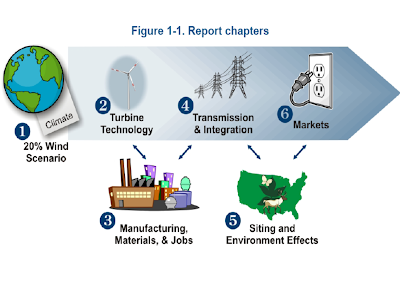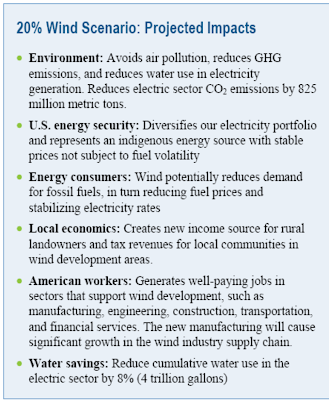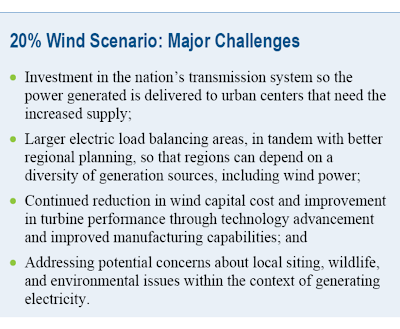WIND: YOU AIN’T SEEN NOTHIN’ YET!
Riding the momentum of unprecedented, record-setting growth, the wind energy industry is said to be ready - in 20% Wind Energy by 2030: Increasing Wind Energy’s Contribution to U.S. Electricity Supply, a new report from the U.S. Department of Energy (DOE) - to provide 20% of U.S. electricity by 2030. DOE expects the wind industry to triple in capacity yearly for the next quarter century.
Andy Karsner, Assistant Secretary of Energy Efficiency and Renewable Energy, DOE: “The United States is currently on a pace to surpass Germany within the next 24 months and restore it to what I think is the rightful place as the world’s renewable energy leader in new energy installations…”
The report is a landmark for the New Energy industries because it represents recognition of wind energy as a viable mainstream energy source and a recognition of the unique value wind and the other New Energies bring to the U.S. energy mix. No less an energy establishment representative than a Federal Energy Regulatory Commission (FERC) member said as much.
Suedeen Kelly, FERC Commissioner: “We must look at meeting future electric demands in a cost-effective way…The 20% wind scenario would only cost 2 percent more than the cost of the baseline scenario without wind. At 50 cents per month for the average ratepayer, that is a small price to pay for the climate, water, natural gas, and energy security benefits it would buy--and it does not even count the stability provided to consumers by eliminating fuel price risk.”
Both in the DOE report and at the press conference announcing the study, the subject of new transmission necessary to deliver the new wind energy was pivotal. (See NewEnergyNews' essay on transmission: GRIDLOCK?) Commissioner Kelly described what is necessary as “…an interstate transmission superhighway system.”
The power industry sees things the same way and is ready to move. Tony Kavanaugh, VP, American Electric Power: “…we cannot expect business as usual to be sufficient. We are looking to craft, in collaboration with a wide range of stakeholders, a different vision of how we move transmission infrastructure construction and development forward in this country and I think the nation is ready for that, I think the electric industry is ready for that, we’re hearing from the policy community that they’re ready for that.”
 DOE has made a comprehensive evaluation and says 20% can be done. (from the report - click to enlarge)
DOE has made a comprehensive evaluation and says 20% can be done. (from the report - click to enlarge)Kevin Kolevar, Assistant Secretary for Electricity Delivery and Energy Reliability, DOE: "The report correctly highlights that greater penetration of renewable sources of energy - such as wind - into our electric grid will have to be paired with not only advanced integration technologies but also new transmission…In many cases, the most robust sources of renewable resources are located in remote areas, and if we want to be able to deliver these new clean and abundant sources of energy to population centers, we will need additional transmission."
The power generation sector has affirmed wind energy’s maturity with its money, buying or partnering on wind installations all across the country. All it asks for in return is new transmission.
Mike Heyeck, Senior VP, AEP Transmission: “…we believe the 20 percent wind scenario is feasible, but only with a major national transmission highway system. Delivering power from the best windy regions to the growing urban supply requires a bigger, stronger transmission system. Strong regional and interregional planning as well as broad allocation of costs will allow the United States to rely on a broader diversity of generation resources…"
 This is what the wind industry is going to do. (from the report - click to enlarge)
This is what the wind industry is going to do. (from the report - click to enlarge)Turns out even the oil industry is interested in wind.
Bob Lukefahr, President, Power Americas/BP Alternative Energy North America: “Wind is an important part of BP Alternative Energy’s business and of BP’s diverse energy portfolio…”
Typical of the wind industry’s open-eyed, honest, forward-thinking approach to growth, it is not turning away from the challenges highlighted in the DOE report – or the value it brings to the effort to overcome them.
Randall Swisher, Executive Director, American Wind Energy Association (AWEA): “The report identifies the central constraints to achieving 20% - transmission, siting, manufacturing and technology - and demonstrates how each can be overcome. As an inexhaustible domestic resource, wind strengthens our energy security, improves the quality of the air we breathe, slows climate change, and revitalizes rural communities.”
Or, as Andy Karsner of DOE put it, “…wind energy is helping us secure a better future for my kids and yours…”
 This is how it is going to do it. (from the report - click to enlarge)
This is how it is going to do it. (from the report - click to enlarge)Major New Technical Report Finds Wind Can Provide 20% Of U.S. Electricity Needs By 2030; U.S. Department of Energy Analysis Finds That Wind Can Be Major Contributor to Energy Mix
May 12, 2008 (American Wind Energy Association)
WHO
Andy Karsner, Assistant Secretary of Energy Efficiency and Renewable Energy, DOE;
Randall Swisher, Executive Director, AWEA; Tony Kavanaugh, VP/Governmental Affairs, American Electric Power; Suedeen Kelly, FERC Commissioner; Kevin Kolevar, Assistant Secretary for Electricity Delivery and Energy Reliability, DOE; Mike Heyeck, Senior VP, AEP Transmission; Bob Lukefahr, President, Power Americas/BP Alternative Energy North America
WHAT
20% Wind Energy by 2030: Increasing Wind Energy’s Contribution to U.S. Electricity Supply
WHEN
- To get to 20% by 2030, according to the study, new wind installations would need to reach 16,000 megawatts/year by 2018 and sustain that rate of growth through 2030.
- 2006: President Bush, for the first time, said “wind energy” in his state-of-the-union address, pointing the way to the 20% goal.
- 2007: Wind was 2nd only to the natural gas industry in building new power generation for the 3rd year in a row.
- 2008 (1st quarter): 1,400 megawatts ($3 billion) of new generating capacity.
 New Energy will need new transmission. (from the report - click to enlarge)
New Energy will need new transmission. (from the report - click to enlarge)WHERE
- The key to wind’s implementation is the building of adequate transmission. Press conference participants suggested that regional groups in New England, the west and Texas are driving the development of new transmission in service to their goals of New Energy and greenhouse gas reduction.
- The 2nd most important challenge left to be conquered is wind’s variability, something that can be managed by adequate transmission, an adequately smart grid and/or breakthroughs in wind storage technology.
- Appropriately siting wind installations is a crucial consideration in the industry’s expansion.
 (from the report - click to enlarge)
(from the report - click to enlarge)WHY
- The DOE report includes an evaluation of (1) U.S. manufacturing capabilities, (2) current U.S. technology, (2) anticipated energy costs, (3) U.S. wind energy resources, (4) wind energy environmental impact limits and factors, and (5) the economics of wind energy.
- According to the report, getting 20% of U.S. electricity from wind would (1) cut power generation CO2 25% in 2030, (2) cut U.S. natural gas consumption 11% (driving the price down), (3) cut 4 trillion gallons from power production water use by 2030, (4) bring $1.5 billion to local communites where wind would be built by 2030, and (5) add a half million jobs to the economy, including 150,000+ in the wind industry and many more in the manufacturing supply chain.
 (from the report - click to enlarge)
(from the report - click to enlarge)QUOTES
- Andy Karsner, Assistant Secretary of Energy Efficiency and Renewable Energy, DOE: "DOE's wind report is a thorough look at America's wind resource, its industrial capabilities, and future energy prices, and confirms the viability and commercial maturity of wind as a major contributor to America's energy needs, now and in the future…To dramatically reduce greenhouse gas emissions and enhance our energy security, clean power generation at the gigawatt-scale will be necessary, and will require us to take a comprehensive approach to scaling renewable wind power, streamlining siting and permitting processes, and expanding the domestic wind manufacturing base."
- Randall Swisher, Executive Director, AWEA: “The report shows that wind power can provide 20% of the nation’s electricity by 2030, and be a critical part of the solution to global warming…”








0 Comments:
Post a Comment
<< Home